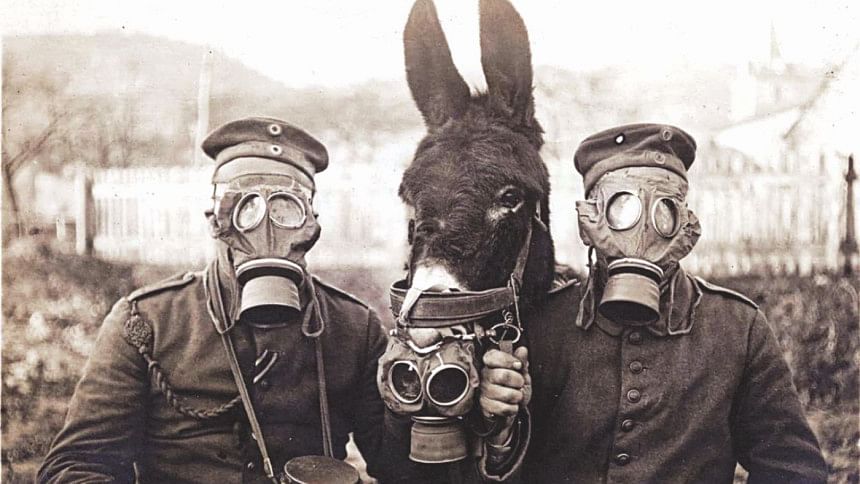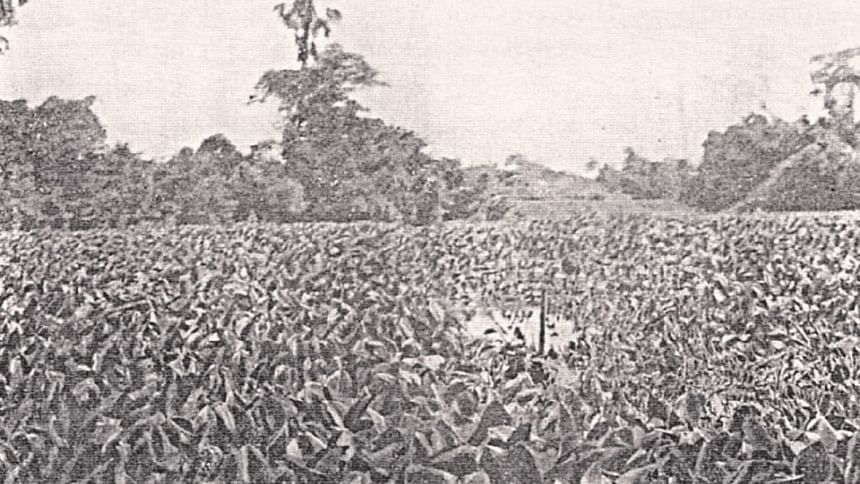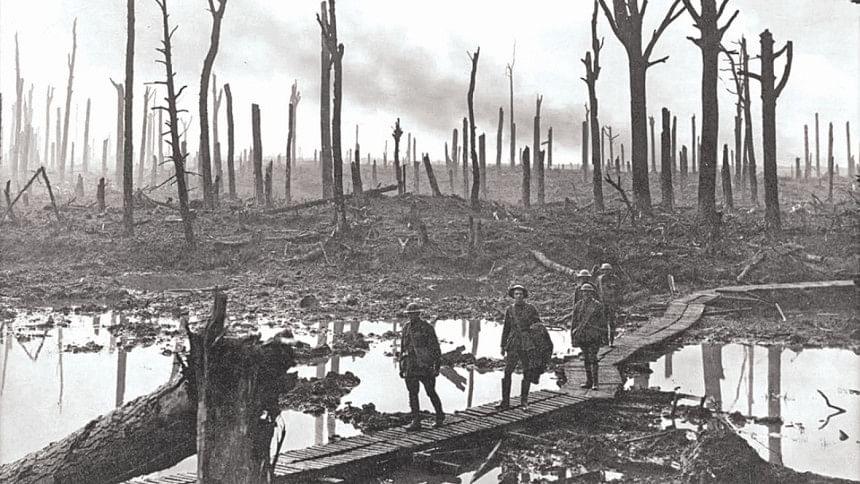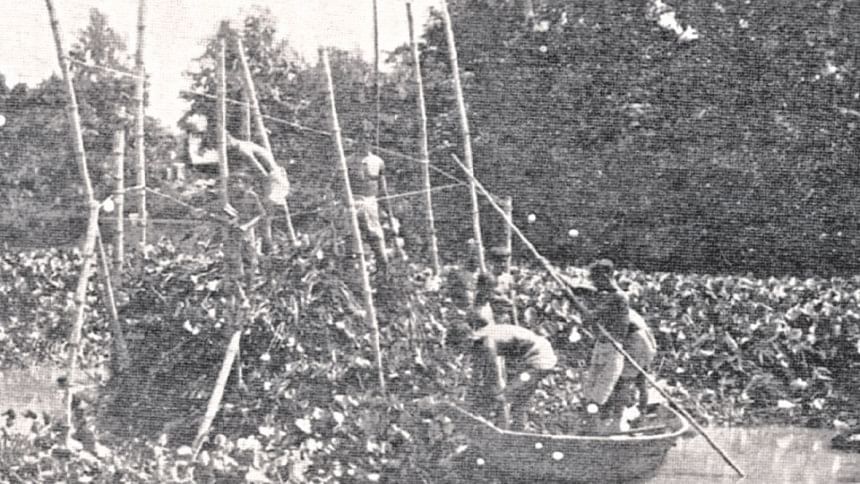How the deadly water hyacinth invaded Bengal

Wars are not just about strategy, diplomacy, weapons, death and destruction of human life, but also about the way it affects natural environment.
Let me start with a poem titled "July 1914" by Russian poet Anna Akhmatova.
All month a smell of burning, of dry peat
Smouldering in the bogs.
Even the birds have stopped singing, the aspen does not tremble.
The god of wrath glares in the sky,
The fields have been parched since Easter.
A one-legged pilgrim stood in the yard
With his mouth full of prophecies:
"Beware of terrible times … the earth
Opening for a crowd of corpses.
Expect famine, earthquakes, plagues,
And heavens darkened by eclipses.
This was exactly what happened over the next few years. Obviously the European war theatre was most hard hit. In terms of the direct impact of the war on the environment, dramatic landscape changes took place because of trench warfare. In fact, part of Europe's landscape changed forever. Another damaging impact of the WWI was felt through the use of poison gases. Gases used during WWI included tear gas (aerosols causing eye irritation), mustard gas (cell toxic gas causing blistering and bleeding), and carbonyl chloride (carcinogenic gas).
Of all the millions of people who died during and immediately after the war, a majority were civilians. Those soldiers who came back with malaria, dysentery, tuberculosis, sexually transmitted diseases, typhoid, influenza or other disease infected local people. A great example of the war-related disease mortality was caused by the Spanish Flu. The war did not directly cause the influenza outbreak, but it was amplified because of the war. Mass movement of troops and close quarters caused the Spanish Flu to spread quickly. While the War claimed an estimated 16 million lives, the influenza epidemic that swept the world in 1918 killed an estimated 50 million people. One fifth of the world's population was attacked by this deadly virus. Outbreaks swept thorough North America, Europe, Asia, Africa, Brazil and the South Pacific (Taubenberger).

In India the mortality rate was extremely high at around 50 deaths from influenza per 1000 people. In India alone more than 15 million people died. In Africa and Madagascar, about 1. 5 million people died of the deadly flu. Some scholars thought of the epidemic as a biological warfare tool of the Germans. Many thought it was a result of the trench warfare, the use of the mustard gases and the generated "smoke and fumes" of the war.
J R McNeill writes in "Woods and Warfare in World History" that "After the Battle of Tannenberg in Poland in 1914, the Germans cleared five percent of the Lithuanian forest of Bia Bowieza, formerly maintained as the Tsar's hunting grounds, taking five million cubic meters of wood back to Germany." A system of trenches 250 miles long used endless trainloads of wood for the trenches themselves and for shelter, heating, and transport network. By the end of the war, the French Forestry Service estimated that 350,000 hectares of forest—enough trees to have been harvested for sixty years—had been totally destroyed. In other parts of the world, during 1917-18, 30,000 US and Canadian battalions were cutting trees.
When Indian soldiers were dying in many parts of the world huge number of trees were being cut in India. For example, British campaigns in Iraq, Gallipoli, and the Balkans (1915-1918) led to an upsurge in timber-cutting in India. Consumption of steel for military purposes by the Western European soldier in the WWI was from two to two and a half tons per head in the field. India produced 6.12 mts per year in 1900 but it grew to 18 mts per year by 1920. The production got a sudden boost from the War. What was the impact of coalmining during the War in India is open for further examination.

***
From the global and regional scenes, let us now briefly turn to Bangladesh. It may sound a bit of a stretch of thought, but it can be argued that there were environmental implications of the First World War for Bangladesh. This issue could be examined with the example of the water hyacinth—kochuripana. First, a few words on the extent of the problem of the water hyacinth.
A conservative estimate revealed that in the 1920s and 1930s the water hyacinth covered an area of over 4000 square miles. During this period the annual damage done by this weed in Bengal was estimated at more than six crore (60 million rupees). Recent researches suggest that the water hyacinth continued to create havoc in the region leading to malaria, cholera, and diarrhoea. The crop failure due to water hyacinth is also considered to have contributed to the great Bengal famine during the Second World War, which killed about three million people. Now there is this theory, at least found in British archives, that the rapid spread of this weed in Bengal during the First World War could be traced to the Germans who wanted to weaken the British by "killing their Indian subjects". In fact it has since been known as German pana or German weed. So, if the German attempt to suffocate the waterways by German pana is even partially true, then this can be connected to the history of the First World War.
If we take this story for certain, we can readily suggest that the War had direct impact on the environment of Bangladesh—an impact that continued to be felt during the Second World War. And if we are to believe the British officials, it was the Germans who were responsible for this. But a closer look at the problem will suggest that there might be another perspective to this issue.
This different perspective has its roots in the fact that the British colonial state and a multinational company, Shaw Wallace, were very keen on promoting water hyacinth during the First World War. In the context restricted global access to potash because of the War, the Shaw Wallace company urged the government of Bengal to "make it known among the agriculturists and those who can promote the scheme". The company suggested that if the ash had reached them in good condition and was not adulterated, they were ready to pay between Rs 84 and Rs 112 per tonne.

Accordingly, the government of Bengal started research on ways to best produce water hyacinth. After conducting experiments in the Dhaka Agricultural Farm in 1916, government officials suggested that apart from high potash content, the water hyacinth was at least as rich as farmyard manure in terms of both nitrogen and phosphoric acid. In a more specific analysis, the experts-cum-bureaucrats found that the nitrogen content of the dry material was as high as 2.24 percent and in the damp state (containing 67.8 percent of water) it was only 0.72 percent The experts noted that the rotting process involved a loss of about 70 percent of the available potash and 60 percent of nitrogen. In other words, the key finding of the research was that burning the water hyacinth to ash was much better than rotting it in terms of nutrient value. The Shaw Wallace Company was not satisfied by the quality of the hyacinth supplied in the early phases of the transaction, and in 1918, the company directors informed the government of India that in future they would not buy any ash containing less than 15 percent of potash, which was worth less than Rs. 2.4 per maund after reaching Kolkata. Consequently, the government of India advised the people to cultivate water hyacinth properly and methodically. So it seems it was the British private and state interest which promoted the growth of the water hyacinth.
Now I would like to conclude by referring to Bangladesh's national poet Kazi Nazrul Islam. It is rightly suggested that the First World War had a great formative contribution in raising nationalist sentiment and anti-colonial political awareness. Kazi Nazrul Islam is one great example of such impact as has been suggested on many occasions. It may just be added here that as Nazrul started resisting the colonial regime in the years after his return, he also found enough reason to resist environmental problems caused by the water hyacinth, by all means a legacy of the First World War. In other words, Nazrul returned from the war front with political impetus for freedom, but he had also to fight against other kind of problems facing the public square, in the wake of the War. I am saying this on the strength of a poem written by Nazrul, perhaps in the late 1920s:

Destroy this water hyacinth
They are not plants, but children of foreign devils
Destroy them in full
Put them on fire and burn them to ashes
They are the enemy of life and a strangler
They are the teeth of a monster, the wings of a cannibal
Destroy this water hyacinth
They are the agents of malaria, famine and the hell
They are the harbinger of bad luck and devastating plague
One by one, they swallow rivers and canals,
Rivulets, streams, ponds, fields and drains
Destroy this water hyacinth
They are the curse of Bengal, poisonous sin
Let's clear them from the roots
They have turned the green Bengal into graveyard
They are the devil's ambassador
Destroy this water hyacinth
Hoods of black snacks peep through their leaves
They are the endless breeds of goblins who live forever
Brothers, if they don't die we all die
Eliminate them, please don't listen otherwise
Destroy this water hyacinth
(See "Poribeshbadi Non, Kobi" by Iftekhar Iqbal, Prothom Alo, 2006)
Thus the perception that there was not much environmental impact of the WWI on the colonised or non-European world is not tenable. The war indeed was linked to many political and social issues, but it also ushered in huge ecological problems in places even where the battles were not fought. And in this process conscious human agencies were active. The most critical impact of the WWI was on the withering of environmental awareness that was built up in the course of the nineteenth century through the works of Henry David Thoreau, Alexander von Humboldt and George Forster, among many others from Asia and Africa. Such loss of awareness about the need of an ecologically balanced planet was another factor that gave way to the Second World War.
Iftekhar Iqbal is a historian at the Universiti Brunei Darussalam, Brunei. He is the author of The Bengal Delta: Ecology, State and Social Change, 1840-1943 (Basingstoke; New York: Palgrave Macmillan, 2010). For a detailed discussion of the First World War's environmental impact on Bangladesh and parts of South Asia, see Iftekhar Iqbal, "The First World War and the Global Environment: A View From South Asia", in Katrin Bromber, Katharina Lange, Heike Liebau, Anorthe Wetze (eds.), The Long End of the First World War: Ruptures, Continuities and Memories (Frankfurt; New York: Campus Verlag, 2018).





Comments